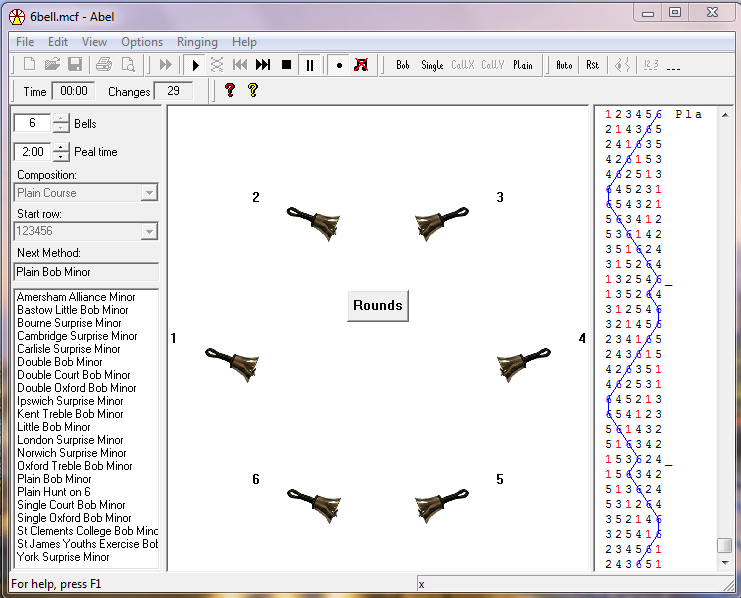Handbell Manager
The dummy handbell interface for change ringing simulators.

Menu:
Updates:
Nov, 2020:
eBells available to order.
Oct, 2020:
Handbell Manager Version 2.0 released.
Dec, 2020:
Support for Ding added in Version 2.1.
Abel »
Beltower »
Ding »
Muster »
Ringing Room »
eBells »
GitHub »
“This is easily, by far, the best development to happen to handbell learning. Whilst a good tutor is invaluable in guiding one's learning experience, this gives every 'would be' learner and developer of handbell skills the ability to expand their skills at any time, anywhere, and in an accelerated timescale. It could easily lead to an explosion in change ringing on handbells, and I think will.”
Richard Grimmett
Background
Learning methods
Towerbell ringers can learn methods and test themselves quite easily by reciting the work of a method or by drawing out the blue line on paper. If they can do this quickly and without error, and their ropesight is good, they can be confident that this will translate into a reliable performance in the tower. However, for handbell ringers it is much harder to confirm whether they know a method well enough to ring it on handbells, because knowing a single line or a grid pattern doesn’t mean that you can ring two bells based upon this knowledge. To demonstrate that you know a method by drawing it on paper, you would have to be able to draw two lines simultaneously. This is impracticable. The alternative, and one that some handbell ringers use, is to practice methods with a simulator such as Abel or Beltower, using two keys on the keyboard to ring their two bells while the simulator rings the rest.
Ringing Handbells Using the Keyboard is Hard!
Some ringers seem to manage to ring a simulator such as Abel using the keyboard quite successfully, but it is generally acknowledged that this is much harder than practising with real ringers. There are a number of reasons for this, including:
- There is no distinction between handstroke and backstroke when pressing keys. Using Abel’s keyup/keydown option helps with this, but it is no substitute for swinging one's arms up and down.
- Using the keyboard, you cannot “internalise” a rhythm based upon the movement of your arms and the timing of the swing.
- The handbell equivalent of “ropesight” is difficult as Abel’s screen bells flip instantly between strokes. With real ringers you see the bell you are going to follow start to move, and this helps you anticipate the swing of your own bell to ring after it.
Dummy Handbells
Abel’s documentation suggests using dummy handbells with electronic switches for clappers to overcome points 1 and 2, and includes a design to help individuals build their own. Although a few people have successfully built dummy handbells for their own use, mechanical designs are prone to problems such as bounce and unwanted rattle, the design is beyond many ringer’s DIY skills, and no one has built any for general sale to others. Recent correspondence on ringing lists has suggested that there is an unsatisfied demand for dummy handbells suitable for use with Abel.
Motion Controllers
In recent years, motion controllers have been introduced into console games, most notably on the Nintendo Wii, where simulation games have been created for many action sports, using wireless motion controllers to simulate rackets etc. Some of these Wii games use controllers in a shaking action to simulate ringing handbells to tunes, as shown by this Japanese video demonstrating tune ringing.
It therefore seemed feasible that motion controllers could solve the dummy handbell problem for change ringers too. The questions then raised were “Are there USB motion controllers available for PCs?” and if there are “How can they operate Abel?”. The answer to the first of these questions is “Yes” — at least one company (ActionXL) makes both wired and wireless motion controllers for PCs, and the answer to the second is now “Yes”, as Handbell Manager has been developed to provide an interface to Abel and Beltower.
Enhancements to Handbell Manager
After successfully releasing Handbell Manager for use with Abel, it has been enhanced to work equally well with Beltower. Beltower has a feature called Co-operative Timing that means that the simulator bells will hold up if you strike your bells late, just like other ringers will in practice. This can help the learning process as you are improving your familiarity with a method and your accuracy of striking.
In 2020 Handbell Manager has been enhanced by Adrian Nash and Mike Pidd to work with Ringing Room and Muster.
Enhancements to Abel
As a result of discussions with Chris Hughes, author of Abel, during the development of Handbell Manager, some enhancements to Abel were identified that will make ringing dummy handbells much easier. In particular, the introduction of moving rather than flipping handbells on screen to address point 3 above and make handbell "ropesight" very much easier to see. Together with the use of dummy handbells, these enhancements take the experience of ringing handbells with Abel a big step closer to the real thing.
Version 3.7 and later of Abel includes these enhancements and is available from www.abelsim.co.uk.
Enhancements to Beltower
Derek Ballard, author of Beltower, has made some enhancements to make the use of motion controllers with Beltower easier.
Version 10.27 and later of Beltower includes these enhancements and is available from www.beltower.co.uk.


